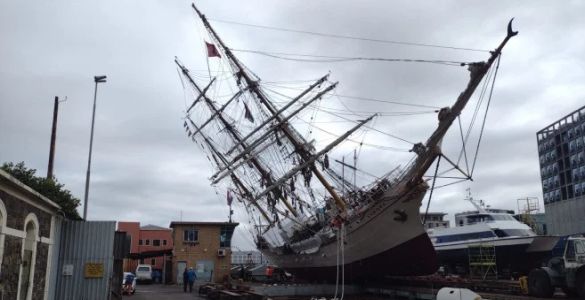 The 112-year-old steel-hulled bark Europa slipped on her side while attempting to be placed back into the water from a drydock at the V&A Waterfront in Cape Town, South Africa on Saturday morning. One crew member was injured, but is reported to be in stable condition and receiving appropriate medical care.
The 112-year-old steel-hulled bark Europa slipped on her side while attempting to be placed back into the water from a drydock at the V&A Waterfront in Cape Town, South Africa on Saturday morning. One crew member was injured, but is reported to be in stable condition and receiving appropriate medical care.
The extent of the damage to the ship is being assessed, and currently, no determination has been made as to the exact timeline for resuming sailing operations. The accident comes less than a month before the vessel was scheduled to embark on a 53-day sail training voyage to the Portuguese island city of Horta in the Azores, on June 13th.
Europa is 39.8 m (131 ft) long and is registered in the Netherlands. She was originally built as a German lightship, Senator Brockes, in 1911 at the H.C. Stülcken & Sohn shipyard in Hamburg, Germany. Until 1977, she served as a lightship on the river Elbe. In 1994, she was fully restored as a bark and retrofitted for special-purpose sail training.
Europa cruises worldwide and accepts paying voyage crew (trainees) for short or long trip segments, including ocean crossings, Sail Training Association races, and annual voyages to Antarctica, and between South Georgia, Tristan da Cunha, and Cape Town.

There have been several incidents of similar accidents in recent months. Perhaps the knowledge and practice of drydocking stability is not being understood and practiced in some shipyards.
I remember, some 60 years ago now, that one of the questions of the Stability exam. when sitting my British Master F.G. was on this very subject.
When a ship is drydocked her support has to be transferred from water to keel blocks. As soon as she touches the keel blocks she loses displacement and a weight equal to this lost displacement is transferred to the blocks. Again when flooding the drydock to refloat her the reverse occurs. If the vessel’s ballasting is not correctly calculated things can go wrong quite quickly. This appears to have happen in these cases.
Further to my comment. The added weight of masts and rigging caused considerable leverage. This no doubt added to the incident.
Good Watch
https://www.barkeuropa.com/logbook/detail/update-from-the-ship?fbclid=IwAR2hgEvMBYQXpF4WNTrwNIYMtugFYR7xXx7lb0tKWAQEVYh7MhBjqcBzyUY
Regarding Robert Kennedy links; these are PR statements and while having a place in the organization’s operation do not address the issue.
The safety of a ships crew depends on many things and stability is a very important one of those. It is essential that the ships officers understand and put into daily practice the calculations necessary to maintain it. Drydocking stability is one of the more risky operations due to the changes that occur, virtually in an instant, as the vessel goes from blocks to water or the reverse.
Based on my 50 years of seagoing experience and having done this numerous times in shipyards worldwide it does not appear to me that this was done in this case.
Best wishes to the recovering crew member and
Good Watch
Unless it was moved, it looks like the incident occurred during the side-transfer of the vessel, before it got to the lift.